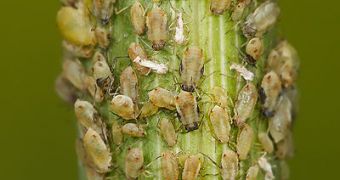Aphids are generally known for having a society that is separated in classes, in which workers collect food, soldiers fight enemies, and others attend to the youngsters. But a new research has revealed that these tiny insects are full of surprises. Scientists noted that the soldier class not only engaged in battles, but also played a very important role domestically, and not by hunting outlaws in the colony, but for repairing wooden structures known as gails. Better said, they know how to condition the tree to do it itself, with only little help from the actual aphids.
When aphids first colonize a tree, they somehow induce it to grow a hallow, wooden structure known as the gail, in which the aphids move, set up headquarters, and begin consuming the wood from the inside. However, from time to time, the gail is breached, for various reasons. When a gap occurs, soldiers exit through it, and begin pumping bodily fluids inside the hole, to bridge the gap. And they do so with utter disregard for their lives, or the lives of others. Generally, all aphids that exit the nest in an attempt to fix it die on the outside, or get caught in the plug itself.
On the inside of the gail, other workers continue their work of fixing the damage, but, at the same time, they secrete substances that incite the tree to start growing wood where the hole is. Eventually, the gap is sealed, and the rudimentary repair that the aphids made is replaced with solid wood. Studies have shown, however, that this no longer happens when the aphids inside the gail are dead, which leads to the natural conclusion that they must somehow be interfering with the tree itself growing and healing.
While this will most likely remain a subject of speculation for a long time to come, a new research published in the latest issue of the scientific journal Proceedings of the Royal Society B clearly shows that aphids are, in fact, so well organized that they could rival bees, ants and termites in terms of societal complexity and their ability to influence their environment, LiveScience reports.

 14 DAY TRIAL //
14 DAY TRIAL //